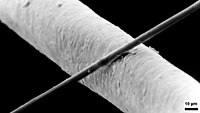
Photo from wikipedia
As biodegradable and eco-friendly bio-resources, polysaccharides from a wide range of sources show steadily increasing interest. The increasing fossil-based production of materials are heavily associated with environmental and climate concerns,… Click to show full abstract
As biodegradable and eco-friendly bio-resources, polysaccharides from a wide range of sources show steadily increasing interest. The increasing fossil-based production of materials are heavily associated with environmental and climate concerns, these biopolymers are addressing such concerns in important areas such as food and biomedical applications. Among polysaccharides, high amylose starch (HAS) has made major progress to marketable products due to its unique properties and enhanced nutritional values in food applications. While high amylose-maize, wheat, barley and potato are commercially available, HAS variants of other crops have been developed recently and is expected to be commercially available in the near future. This review edifies various forms and processing techniques used to produce HAS-based polymers and composites addressing their favorable properties as compared to normal starch. Low toxic and high compatibility natural plasticizers are of great concern in the processing of HAS. Further emphasis, is also given to some essential film properties such as mechanical and barrier properties for HAS-based materials. The functionality of HAS-based functionality can be improved by using different fillers as well as by modulating the inherent structures of HAS. We also identify specific opportunities for HAS-based food and biomedical fabrications aiming to produce cheaper, better, and more eco-friendly materials. We acknowledge that a multidisciplinary approach is required to achieve further improvement of HAS-based products providing entirely new types of sustainable materials.
Journal Title: Polymers
Year Published: 2022
Link to full text (if available)
Share on Social Media: Sign Up to like & get
recommendations!